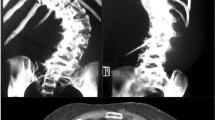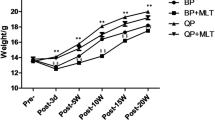Abstract
The pathological mechanism of curve progression in idiopathic scoliosis is still obscure. In this study we investigated the pathological mechanism of idiopathic scoliosis in experimentally induced scoliosis in rats. A total 30 rats were divided into three groups: ten bipedal rats with a sham operation, which served as the control; ten quadrupedal rats with pinealectomy; and ten bipedal rats with pinealectomy. Scoliosis developed only in pinealectomized bipedal rats and not in pinealectomized quadrupedal rats. Cervicothoracic lordosis developed in bipedal rats with or without pinealectomy. These deformities of lordoscoliosis in pinealectomized bipedal rats were similar to human idiopathic scoliosis. Lordosis or lordotic tendency was sufficient to cause the spine to rotate to the side. Rotational instability of the spine with rotation of lordotic segment appears to produce a characteristic scoliotic deformity as a secondary phenomenon. Our findings suggest that lordosis may develop in bipedal rats, but pinealectomy is required for the development of lordoscoliosis. Balanced muscle tone controlled by the postural reflex is important to maintain normal posture with a straight spine in the bipedal condition. The disturbance of equilibrium and other postural mechanisms secondary to a deficiency of melatonin after pinealectomy may promote development of lordoscoliosis with vertebral rotation especially in the bipedal posture.



Similar content being viewed by others
References
Adams W (1865) Lectures on the pathology and treatment of lateral and other forms of curvature of the spine. Churchill & Sons, London
Alexander MA, Bunch WH, Ebbesson SOE (1972) Can experimental dorsal rhizotomy produce scoliosis? J Bone Joint Surg Am 54:1509–1513
Bailey AS, Alder FA, Lai SM, Asher MA (2001) A comparison between bipedal and quadrupedal rats; do bipedal rats actually assume an upright posture? Spine 26:E308–E313
Barrios C, Tunon MT, DeSalis JA, Beguiristain JL, Canadell J (1987) Scoliosis induced by medullary damage: an experimental study in rabbits. Spine 12:433–439
Barrios C, Arrotegui JI (1992) Experimental kyphoscoliosis induced in rats by selective brain stem damage. Int Orthop 16:146–151
Cowell HR, Hall JN, MacEwen GD (1972) Genetic aspects of idiopathic scoliosis. Clin Orthop 86:121–131
DeSalis J, Beguiristain JL, Canadell J (1980) The production of experimental scoliosis by selective arterial ablation. Int Orthop 3:311–315
Dickson RA, Lawton JO, Archer IA, Butt WP (1984) The pathogenesis of idiopathic scoliosis: biplanar spinal asymmetry. J Bone Joint Surg Br 66:8–15
Fidler MW, Jowett RL (1976) Muscle imbalance in the aetiology of scoliosis. J Bone Joint Surg Br 58:200–201
Fischer RL, DeGeorge FV (1976) Idiopathic scoliosis: an investigation of genetic and environmental factors. J Bone Joint Surg Am 49:1005–1006
Fraschini F, Cesarani A, Alpini D, Esposti D, Stanker BM (1999) Melatonin influences human balance. Biol Signals Recept 8:111–119
Goff CW, Landmesser W (1975) Bipedal rats and mice. J Bone Joint Surg Am 39:616–622
Kazmin AI, Merkorieva RV (1971) Role of disturbance of glucosaminoglycaine metabolism in the pathogenesis of scoliosis. Ortop Travmatol Protez 32:87–91
Kindsfater K, Lowe T, Lawellin D, Weinsein D, Akmakjian J (1994) Levels of platelet calmodulin for the prediction of progression and severity of adolescent idiopathic scoliosis. J Bone Joint Surg Am 76:1186–1192
Lagenskiold A, Michelsson JE (1961) Experimental progressive scoliosis in the rabbit. J Bone Joint Surg Br 43:116–120
Lawton JO, Dickson RA (1986) The experimental basis of idiopathic scoliosis. Clin Orthop 210:9–17
Liszka O (1961) Spinal cord mechanisms leading to scoliosis in animal experiments. Acta Med Pol 2:45–63
Machida M, Dubousset J, Imamura Y, Iwaya T, Yamada T, Kimura J (1993) An experimental study in chickens for the pathogenesis of idiopathic scoliosis. Spine 18:1609–1615
Machida M, Dubousset J, Imamura Y, Iwaya T, Yamada T, Kimura J (1995) Role of melatonin deficiency in the development of scoliosis in pinealectomised chickens. J Bone Joint Surg Br 77:134–138
Machida M, Dubousset J, Imamura Y, Iwaya T, Yamada T, Kimura J, Toriyama S (1994) Pathogenesis of idiopathic scoliosis: SEPs in chickens with experimentally induced scoliosis and in patients with idiopathic scoliosis. J Pediatr Orthop 14:329–335
Machida M, Dubousset J, Satoh T, Murai I, Wood KB, Ryu J (2001) Pathological mechanism of experimental scoliosis in pinealectomized chickens. Spine 26:E385–E391
Machida M, Miyashita Y, Murai I, Dubousset J, Yamada T, Kimura J (1997) Role of serotonin for scoliotic deformity in pinealectomized chicken. Spine 22:297–301
Machida M, Miyashita Y, Yamada H, Imamura Y, Murai I (1998) Pathogenesis in idiopathic scoliosis: serum melatonin and scoliotic deformity in chickens in continuous darkness. Spine Spinal Cord 11:135–138
Machida M, Murai I, Miyashita Y, Dubousset J, Yamada T, Kimura J (1999) Pathogenesis of idiopathic scoliosis: experimental study in rats. Spine 24:1985–1989
Machida M (1999) Cause of idiopathic scoliosis. Spine 24:2576–2583
Ohlen G, Aaro S, Byland P (1988) The sagittal configuration and mobility of the spine in idiopathic scoliosis. Spine 13:413–416
O’Kelly C, Wang X, Raso J, Moreau M, Mahood J, Zhao J, Bagnall K (1999) The production of scoliosis following pinealectomy in young chickens, rats and hamsters. Spine 24:35–43
Pincott JR, Davies JS, Taffs LF (1984) Scoliosis caused by section of dorsal spinal nerve roots. J Bone Joint Surg Br 66:27–29
Roaf R (1966) The basic anatomy of scoliosis. J Bone Joint Surg Br 48:786–792
Rodriguez RM, Bailey RW, Rodriguez RP (1965) Skeletal lesions of lathyrism effects of bipedalism on spine development. Clin Orthop 41:189–197
Sahlstrand T, Ortengren R, Nachemson A (1978) Postural equilibrium in patients in adolescent idiopathic scoliosis. Acta Orthop Scand 49:354–365
Sarwark JF, Dabney KW, Salzman SK, Wakabayashi T, Kitadai HK, Beachamp JT, Beckman AL, Bunnel WP (1988) Experimental scoliosis in rat. 1. Methodology, anatomic features and neurologic characterization. Spine 13:466–471
Smith RE, Saville PD (1965) Bone breaking stress as a function of weight bearing in bipedal rats. Am J Phys Anthropol 25:159–164
Smith RM, Dickson RA (1987) Experimental structural scoliosis. J Bone Joint Surg Br 69:576–581
Somerville EW (1952) Rotational lordosis: the development of single curve. J Bone Joint Surg Br 34:421–427
Waldhauser F, Weiszenbacher G, Tatzer E, Gisinger B, Waldhauser M, Schemper M, Frisch H (1988) Alterations in nocturnal serum melatonin levels in humans with growth and aging. J Clin Endocrinol Metab 66:648–652
Wan Q, Pang SF (1994) Segmental, coronal, and subcellular distribution of 2-[125I] iodomelatonin binding sites in the chicken spinal cord. Neurosci Lett 180:253–256
Wyatt MP, Barrack RL, Mubarak SJ, Whitecloud TS, Burke SE (1986) Vibratory response in idiopathic scoliosis. J Bone Joint Surg Br 68:714–718
Wyanne-Davies R (1968) Familial (idiopathic) scoliosis. A family survey. J Bone Joint Surg Br 50:24–30
Yamada K (1962) The dynamics of experimental posture: experimental study of intervertebral disc herniation in bipedal animals. Clin Orthop 25:20–31
Yamada K, Ikata I, Yamamoto H, Nakagawa Y, Tanaka H, Tezuka A (1969) Equilibrium function in scoliosis and active corrective plaster jacket for the treatment. Tokushima J Exp Med 16:1–7
Yamada K, Yamamoto H, Nakagawa Y, Tezuka A, Tamura Y, Kawata S (1984) Etiology of idiopathic scoliosis. Clin Orthop 184:50–57
Yamamoto H (1966) Experimental scoliosis in rachitic bipedal rats. Tokushima J Exp Med 13:1–34
Acknowledgements
This study was conducted at the Department of Orthopaedic Surgery, Nihon University School of Medicine, Tokyo, Japan. None of the authors received financial support for this study.
Author information
Authors and Affiliations
Corresponding author
Rights and permissions
About this article
Cite this article
Machida, M., Saito, M., Dubousset, J. et al. Pathological mechanism of idiopathic scoliosis: experimental scoliosis in pinealectomized rats. Eur Spine J 14, 843–848 (2005). https://doi.org/10.1007/s00586-004-0806-1
Received:
Accepted:
Published:
Issue Date:
DOI: https://doi.org/10.1007/s00586-004-0806-1




